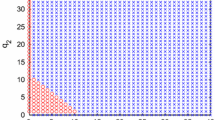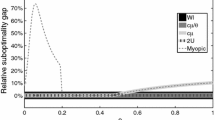Abstract
We address the problem of schedulingM customer classes in a single-server system, with customers arriving in one ofN arrival streams, as it arises in scheduling transmissions in packet radio networks. In general,N≠M and a customer from some stream may join one of several classes. We consider a slotted time model where at each scheduling epoch the server (channel) is assigned to a particular class (transmission set) and can serve multiple customers (packets) simultaneously, one from every arrival stream (network node) that can belong to this class. The assignment is based on arandom polling policy: the current time slot is allocated to theith class with probability θi. Our objective is to determine the optimal probabilities by adjusting them on line so as to optimize some overall performance measure. We present an approach based on perturbation analysis techniques, where all customer arrival processes can be arbitrary, and no information about them is required. The basis of this approach is the development of two sensitivity estimators leading to amarked slot and aphantom slot algorithm. The algorithms determine the effect of removing/ adding service slots to an existing schedule on the mean customer waiting times by directly observing the system. The optimal slot assignment probabilities are then used to design adeterministic scheduling policy based on the Golden Ratio policy. Finally, several numerical results based on a simple optimization algorithm are included.
Similar content being viewed by others
References
D. Bertsekas and R. Gallager,Data Networks (Prentice-Hall, 1992).
O.J. Boxma and J.A. Weststrate, Waiting times in polling systems with Markovian server routing, preprint (1989).
P. Bremaud and FJ. Vazquez-Abad, On the pathwise computation of derivatives with respect to the rate of a point process: The phantom RPA method, Queueing Systems 10 (1992) 249–270.
X.R. Cao, Convergence of parameter in a stochastic environment, IEEE Trans. Autom. Contr. AC-30 (1985) 834–843.
E.K.P. Chong and P.J. Ramadge, Convergence of recursive optimization algorithms using IPA derivative estimates, J. Discr. Event Dyn. Syst. 1 (1992) 339–372.
I. Cidon and M. Sidi, Distributed assigned algorithms for multi-hop packet-radio networks, IEEE Trans. Comp. 38 (1989) 10.
P. Dupuis and R. Simha, On sampling-controlled stochastic approximation, IEEE Trans. Autom. Contr. AC-36 (1991) 915–924.
A. Ephremides and T.V. Truong, Scheduling broadcasts in multihop radio networks, IEEE Trans. Commun. 38(4) (1990).
M.C. Fu and J.Q. Hu, On choosing the characterization for smoothed perturbation analysis, IEEE Trans. Autom. Contr. AC-36 (1991).
P. Glasserman,Gradient Estimation via Perturbation Analysis (Kluwer Academic Publ., Boston, 1991).
P. Glynn, Likelihood ratio gradient estimation: An overview,Proc. 1987 Winter Simulation Conf. (1987) pp. 336–375.
W.B. Gong and Y.C. Ho, Smoothed perturbation analysis of discrete-event dynamic systems, IEEE Trans. Autom. Contr. AC-32 (1987) 858–866.
W.B. Gong and H. Schulzrinne, Application of smoothed perturbation analysis to probabilistic routing, Math. Comp. Simul. 34 (1992) 467–485.
H. Heffes and D. Lucantoni, A Markov modulated characterization of voice and data and related statistical multiplexer performance, IEEE J. Select. Areas Commun. SAC-4 (1984) 856–867.
Y.C. Ho and X. Cao,Perturbation Analysis of Discrete Event Dynamic Systems (Kluwer Academic Publ., Boston, 1991).
A. Itai and Z. Rosberg, A golden ratio policy for a multiple-access channel, IEEE Trans. Autom. Contr. AC-29(8) (1984).
V. Julka, C.G. Cassandras and W.B. Gong, Sample path techniques for admission control in multiclass queueing systems with general arrival processes,Proc. Conf. on Information Science and Systems (1992) pp. 227–232.
J. Kiefer and J. Wolfowitz, Stochastic estimation of the maximum of a regression function, Ann. Math. Stat. 23 (1952) 462–466.
L. Kleinrock and H. Levy, The analysis of random polling systems, Oper. Res. 36(5) (1988).
H.J. Kushner and D. S. Clark,Stochastic Approximation for Constrained and Unconstrained Systems (Springer, 1978).
H. Levy and M. Sidi, Polling systems: Applications, modeling and optimization, IEEE Trans. Commun. 38(10) (1990).
B. Mohanty and CG. Cassandras, The effect of model uncertainty on some optimal routing problems, J. Optim. Th. Appl. 77 (1993) 256–290.
R. Nelson and L. Kleinrock, Spatial TDMA: A collision-free multihop channel access protocol, IEEE Trans. Commun. COM-33 (1985) 934–944.
M. Reiman and A. Weiss, Sensitivity analysis for simulations via likelihood ratios, Oper. Res. 37 (1989) 830–844.
H. Robbins and S. Monro, A stochastic approximation method, Ann. Math. Stat. 22 (1951) 400–407.
Z. Rosberg and M. Sidi, TDM policies in multistation packet radio networks, IEEE Trans. Commun. COM-37 (1989) 1.
Z. Rosberg and D. Towsley, Customer routing to parallel servers with different rates, IEEE Trans. Autom. Contr. AC-30 (1985) 1140–1143.
R. Suri and X. Cao, The phantom and marked customer methods for optimization of closed queueing networks with blocking and general service times, ACM Perform. Eval. Rev. 12 (1986) 234–256.
H. Takagi, Queueing analysis of polling models: An update,Stock. Anal. of Comp. and Comm. Syst., ed. H. Takagi (1990).
L. Tassiulas and A. Ephremides, Stability properties of constrained queueing systems and scheduling policies for maximum throughput in multihop radio networks,Proc. 29th IEEE Conf. on Decision and Control (1990).
F.J. Vazquez-Abad and P. L'Ecuyer, Comparing alternative methods for derivative estimation when IPA does not apply directly,Proc. 1988 Winter Simulation Conf.
Author information
Authors and Affiliations
Additional information
This work was supported by the Naval Research Laboratory under contracts N000014-91-J-2025 and N000014-92-J-2017, by the National Science Foundation under grant EID-9212122, and by the Rome Laboratory under contract F30602-94-C-0109.
Rights and permissions
About this article
Cite this article
Cassandras, C.G., Julka, V. Scheduling policies using marked/phantom slot algorithms. Queueing Syst 20, 207–254 (1995). https://doi.org/10.1007/BF01158437
Received:
Revised:
Issue Date:
DOI: https://doi.org/10.1007/BF01158437




